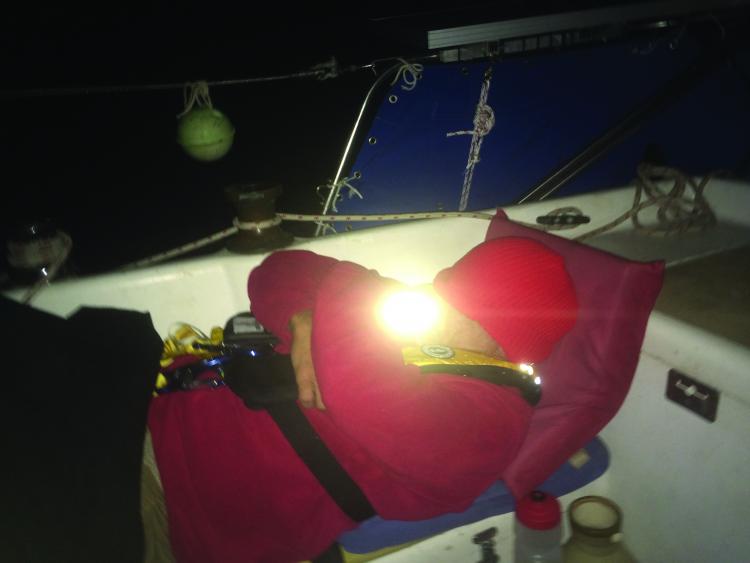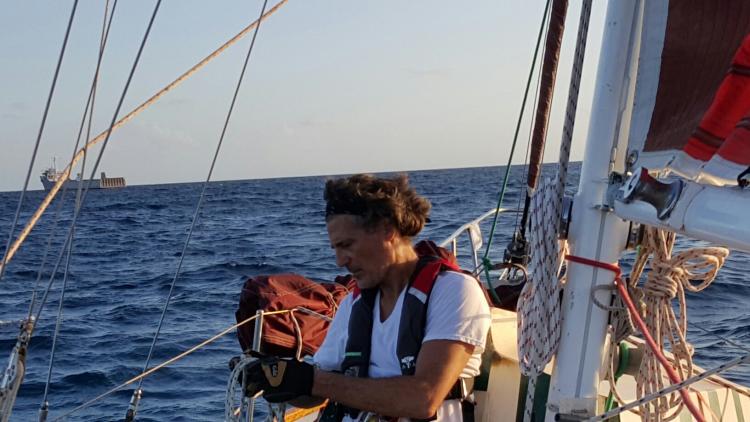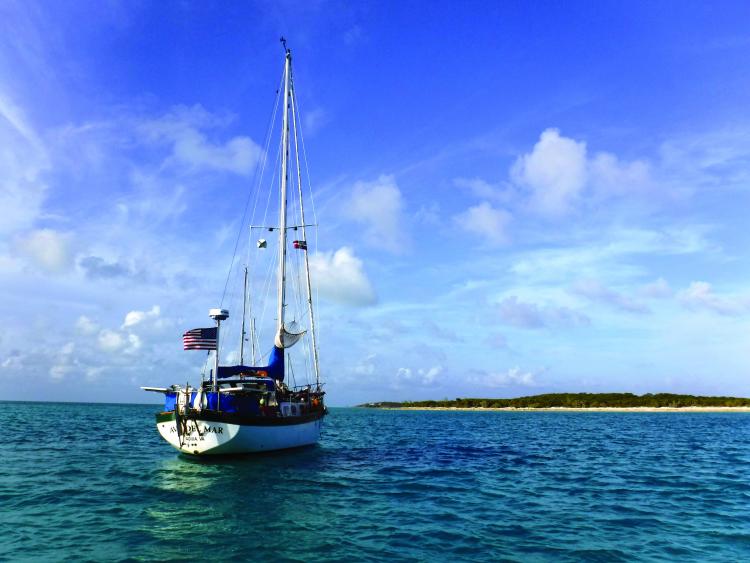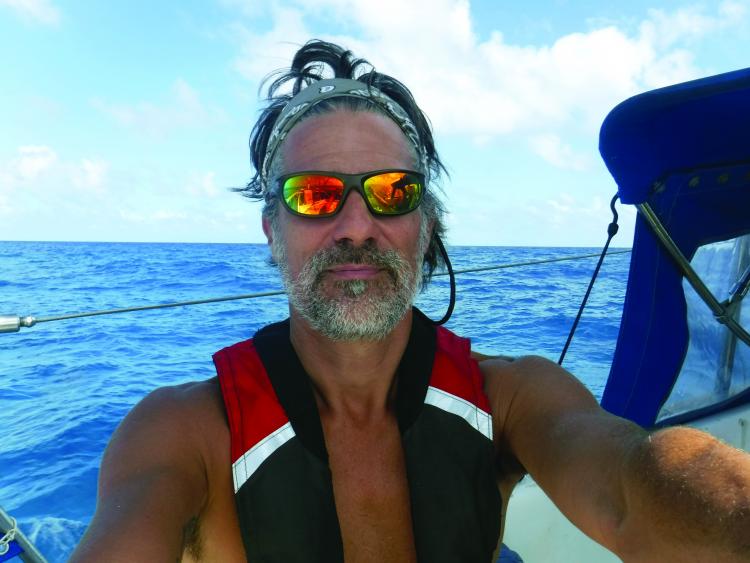Best Practices for Sailing Safely Offshore Inform All Types of Cruising
SpinSheet columnist John Herlig mostly lives aboard his 1967 Rawson 30 cutter Ave del Mar. He has sailed the East Coast between Connecticut and Florida, and the Caribbean from Guatemala to the west to Grenada to the south, as well as cruised extensively through the Bahamas. Here are some of his experiences with onboard safety:
I have a picture of my friend Chris stretched out in the cockpit of my boat, sleeping in the pitch black of a moonless night. We were southbound off the coast of Florida, hugging the shoreline to stay out of the gulf stream and beating into a breeze that was neither light nor from the east, as it was supposed to be. We were close hauled and taking a beating. In the picture the camera’s flash bounces off the reflectors on Chris’s jacket, and what little you can see of him makes it pretty clear that he isn’t all that comfortable. He was also clipped in by a Kong tether.

Safety means different things to different people, and any discussion about it is rife with personal opinion and style. But offshore miles and offshore days give you plenty of time for thought about safety decisions, and the lessons apply on coastal waters, too. The onset of winter gives us a chance to sit back and think about how we will conduct ourselves come summer.
There is only one “Number One Boat Rule” on my boat: Stay On The Boat. There are some co-number-one rules, such as “one hand for yourself and one hand for the boat,” but in the end, staying on the boat trumps everything. It is the granddaddy of boating safety rules. But what else do we have to consider when heading out?
Lifejackets and PFDs
A lifejacket or personal floatation device (PFD) can only keep you alive if you wear it, but let’s also be real here and acknowledge that most folks probably don’t wear one all the time. Fair enough. But whether you are a weekend warrior or an offshore passagemaker, the bottom line remains the same: you need to have the equipment onboard, know how to use it, and apply rational thought as to when. If lifejackets exist on your boat only to satisfy the Coast Guard in the event of a boarding, you’ve already lost the battle.
Having a supply of general-use lifejackets is always smart, and inflatable PFDs can be worn nearly unnoticeably for long periods of time. Many offshore rated PFDs have integrated safety harnesses, important if you are out in unsettled weather and need to clip in. Have PFDs and lifejackets available, adjusted, and wear them when you should.
Tethers and Jacklines
My boat, Ave del Mar, has stout stainless padeyes in the cockpit and jacklines rigged forward for offshore passages. Together with an ISAF-rated double tether, I can navigate my way fully around the decks without ever being unclipped. You probably don’t need that for a Saturday afternoon on the Bay, but don’t lose sight of one overriding truth—that you have the power to render yourself incapable of falling overboard. Whether you are day sailing, racing, or passagemaking, being securely attached to your boat is the safest thing you can do.
Thinking Ahead
I have yet to find a boat with brakes. By the time you need to react to a safety situation, odds are it’s already too late. Your responsibility as the captain is to think ahead—that means for wind, sea state, traffic, sail trim, and a lot more. Know the rules of the road, and go out with an understanding of what local traffic you expect to encounter. Make clear, distinct maneuvers with your vessel to make your intentions clear to others on the water. Think ahead and react early. Encounters with other underway vessels are like bar fights—the best ones are the ones cleverly avoided.

Electronics
I sailed once with a guy who refused to turn on the VHF radio because “all that chatter is annoying.” Well, yeah—but no. Before you undo that last dock line and shove off, is your radio on? Do you know the rules for hailing and what are allowable working channels? Do you know how to make a proper radio check, if one is needed? That little radio you keep on your boat is so much more than a glorified walkie talkie. Make sure it works, make sure you know proper radio etiquette, and make sure it is switched on and accessible.
Deck Rules
On Ave del Mar I won’t let you wear flip flops while we are underway, despite the fact that I practically live in them. Moving backwards in flip flops doesn’t work. Wet flip flops are slippery. Moving securely around on a boat is important. Can folks go forwards down the companionway ladder? Or only backwards? Do you pass inside the shrouds going forward, or outside, or do you weave your way through? Instruct crew and guests how to safely conduct themselves before there is a problem.
Charts
Whether paper or electronic is not the argument here. What is the argument is that you need to know where you are and what the waters around you are hiding. Are you drifting toward shallows? Is there shoaling ahead? Is anchoring allowed where you decided to stop for lunch? Be sure that you have up-to-date charts with you before you head out.
Float Plans
Float plans aren’t just for passagemaking. Let someone know where you’re going, when you’re going, and when you’re expecting to get back. And tell them how long they should wait before they start making concerned calls to the authorities.
And More
Are your batteries healthy? How reliable is your engine? Do you have towing in case things go poorly? Polarized sunglasses? Sunscreen? Plentiful potable water?
Odds are you will rarely “need” to heave to on an afternoon sail on the Bay, and you will rarely need jacklines onboard for a weekend of local exploring, but now is the time to stop and think about how you will conduct your affairs come summer.
And above all else, remember to Stay On The Boat. Your friends will thank you.
About the Author: John Herlig is the author of the “Handy VHF Reference” available on amazon.com. He teaches at Cruisers University during the Annapolis Boat Shows and is the host of the podcast Seabird.






